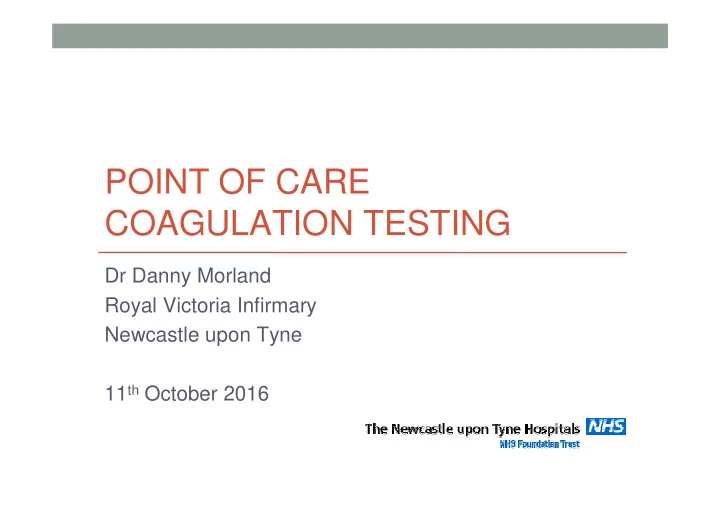

POINT OF CARE COAGULATION TESTING Dr Danny Morland Royal Victoria Infirmary Newcastle upon Tyne 11 th October 2016
Introduction Declarations of Interest: None
CONTENT Introduction to POCT Principles Interpretation Treatment Literature NUTH Experience
Point Of Care Testing (POCT) Medical diagnostic testing at (or near) the point of care.
POCT PROS CONS • Quick • Cost (potentially) • Convenient • Quality • Reliable • Training • Efficient • Workload • Recording • Risk of inappropriate decision-making
Point of Care Coagulation Testing (POCCT) Viscoelastic properties of whole blood clot Thromboelastography = Thromboelastometry (TEG) (ROTEM)
Purported Benefits over Standard Tests • Measures whole blood, not just plasma • Looks at clot generation and propagation beyond the point of clot appearance • Allows comment on clot ‘quality’ • Can identify fibrinolysis FAST –potential information on clotting status within 5mins of test starting
POCCT vs Standard Lab Tests POCCT LAB • Whole blood • Highly standardised • Clot beyond first • Trained, professional staff appearance • Quality control • Clot quality • Well established • Identify fibrinolysis • Complete picture • FAST • Cost
PRINCIPLES
Viscoelasticity
Hardware
OUTPUTS
Panel Testing – Normal results
INTERPRETATION
Normal
Low Platelets
Normal
Hypo-fibrinogenaemia
Heparin Effect
Normal
TREATMENT
LIMITATIONS AND WARNINGS • Treatment should be administered according to the clinical picture (e.g. volume & current rate of blood loss) • Viscoelastic devices are not uniformly sensitive to all disturbances of coagulation status • e.g. platelet dysfunction, antiplatelets, LMWHs, warfarin, DOACs • Pre-existing local protocols should be respected, given current level of evidence for POCCT devices.
Where is it useful? • Perioperative • Livers, cardiac, unanticipated bleeding • Trauma • Pre- and in-theatre • Obstetrics • PPH • ITU
Algorithms
Algorithms
Algorithms
Algorithms
LITERATURE
TRAUMA
http://www.c4ts.qmul.ac.uk/bleeding-and- coalgulation/itactic (Accessed on 9/10/16)
OBSTETRICS
OBSTETRICS
OUR EXPERIENCE
NUTH Experience • Introduced POCCT end of 2014 after an evaluation period to assess feasibility, reliability and accuracy. • Trialled TEG 5000, ROTEM Delta in theatre (POCCT), TEG and ROTEM in lab and compared with standard lab tests coag tests. • Findings • Generally good concordance between POCT and lab tests • Higher user error for more complicated procedures • Sending samples to lab could introduce a delay of 50mins over POCT
NUTH algorithm NOTE – ROTEM does not reliably detect effects of, Physiological Targets: RVI ROTEM Treatment Algorithm � Warfarin � Temp>36°C � Aspirin, Clopidogrel � pH>7.2, Base Excess <-6 � Direct Oral Anticoagulants � iCa >1.0, K+ <5.5 � There may be > 1 clotting defect. LMWH � Hb >80, Plt > 100, Fib >1.5 Treat all defects simultaneously Effect of heparin should be assessed using, � INTEM & HEPTEM tests Patient has significant on-going bleeding? Reassess & OBSERVE NO YES Repeat ROTEM Continue as per Major EXTEM result NORMAL YES Haemorrhage Policy NO EXTEM – CT > 90 sec YES Give 4 FFP +/- YES FIBTEM A10 <10mm Give 2 Unit Cryoprecipitate EXTEM – A10 <40mm +/- Give 1 Pool Platelets FIBTEM A10 > 10mm YES EXTEM – LI30 >5% Give Tranexamic Acid 1g bolus Use these Products to supplement NOT replace the Major Haemorrhage Packs Replace ongoing losses + correct specific deficit = Give contents of MHP + additional products as directed by ROTEM
NUTH Experience since… • Valuable technology, very useful addition to arsenal. • Can be ‘transfusion-sparing’; imparts confidence that management strategy is correct. • Speed of testing and results • Issues • Training • Regular use • QC • Interpretation • IT • Interference with MHP
When is it useful? • To confirm that MHP is addressing specific transfusion requirements of patient (e.g. bleed then DIC) • In cases of slow, steady transfusions that haven’t reached MHP level • To exclude ‘anaesthetic’ bleeding • To confirm that transfusion goals have been achieved
SUMMARY • Viscoelastic, POCCT devices offer the prospect of rapid assessment and rational, individually tailored transfusion therapy in the management of major haemorrhage. • Barriers remain to their effective and efficient use, and in many areas a protocolised transfusion strategy may still produce the best outcomes overall. • Evidence of effectiveness is lacking still, but it is difficult to imagine these devices will not be more widely used in the near future.
THANK YOU
Recommend
More recommend